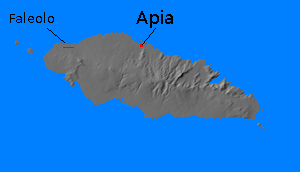![]() The Pacific War Online Encyclopedia
The Pacific War Online Encyclopedia
|
| Previous: APc Class, U.S. Coastal Transports | Table of Contents | Next: Appalachian Class, U.S. Amphibious Command Ships |

Apia (171.772W, 13.827S) was the principal settlement of West Samoa, located on the island of Upolu. Upolu is a large shield volcano resembling Maui in the Hawaiian Islands, with mountainous terrain whose very fertile soil is covered with jungle. Much of the island is geologically young, but the northeastern portion is older and is heavily eroded into steep ridges and valleys. There have been no historic eruptions, but some flows date back just a few hundred years, and nearby Savai'i Island experienced an eruption in 1911. The island is 47 miles (76 km) long and 15 miles (24 km) wide and rises to an elevation of 3607' (1099 meters). There is a fringing reef off most of the coast.
The island had been controlled by New Zealand since 1920 under a
Class C mandate, which was resented by the natives for its
implication that they were primitive people incapable of
self-government. This led to considerable unrest in the early 1930s,
but by 1942 major changes in administration had made the situation more
harmonious. In 1940 the population was 400 New Zealanders and
Europeans, 61,000 natives and 3000 persons of mixed ancestry. There were also
330 Chinese and 75 Melanesian
laborers left from a force of 3100 brought in by the previous German administration.
Apia harbor, as it existed prior to the war, was described by one visitor as a foul, treacherous bowl with barely room for five ships and little protection from the open sea to the north. Cargoes had to be offloaded using lighters. Nevertheless, the settlement occupied a strategic position on the route from the U.S. West Coast to Australia, and a small airstrip had been constructed by 1941. The island had a rudimentary narrow-gauge railroad (two separate short lines) to serve the copra plantations. There were also a number of rubber and tropical fruit plantations.
The garrison in late 1941 was just 157 native
troops. In March 1942 the U.S.
7
Marine Defense Battalion arrived to supplement the garrison, and it
was joined on 30 May by 3
Marine Brigade. Seabees
arrived in 1 April 1942. The Seabees had completed a 4000' (1200 meter)
runway near Faleolo (172.006W 13.829S)
at the northwest end of the island by July and this
was lengthened to 6000' (1830 meter) by early 1943. The airfield was
close enough to shore to have a number of seaplane ramps. Many of the
Marines later showed symptoms of filariasis contracted while on Upolu, and the Marines eventually were forced to abandon Samoa as a training area.
Climate Information:
Elevation 7'
Temperatures: Jan 86/75, Apr 86/75, Jul 85/74, Oct 85/75, record 93/63
Rainfall: Jan 22/17.9, Apr 14/10.0, Jul 9/3.2, Oct 14/6.7 == 112.3" per annum
References
Shaw and Kane (1963; accessed 2012-9-14)
The Pacific War Online Encyclopedia © 2007, 2010, 2012 by Kent G. Budge. Index